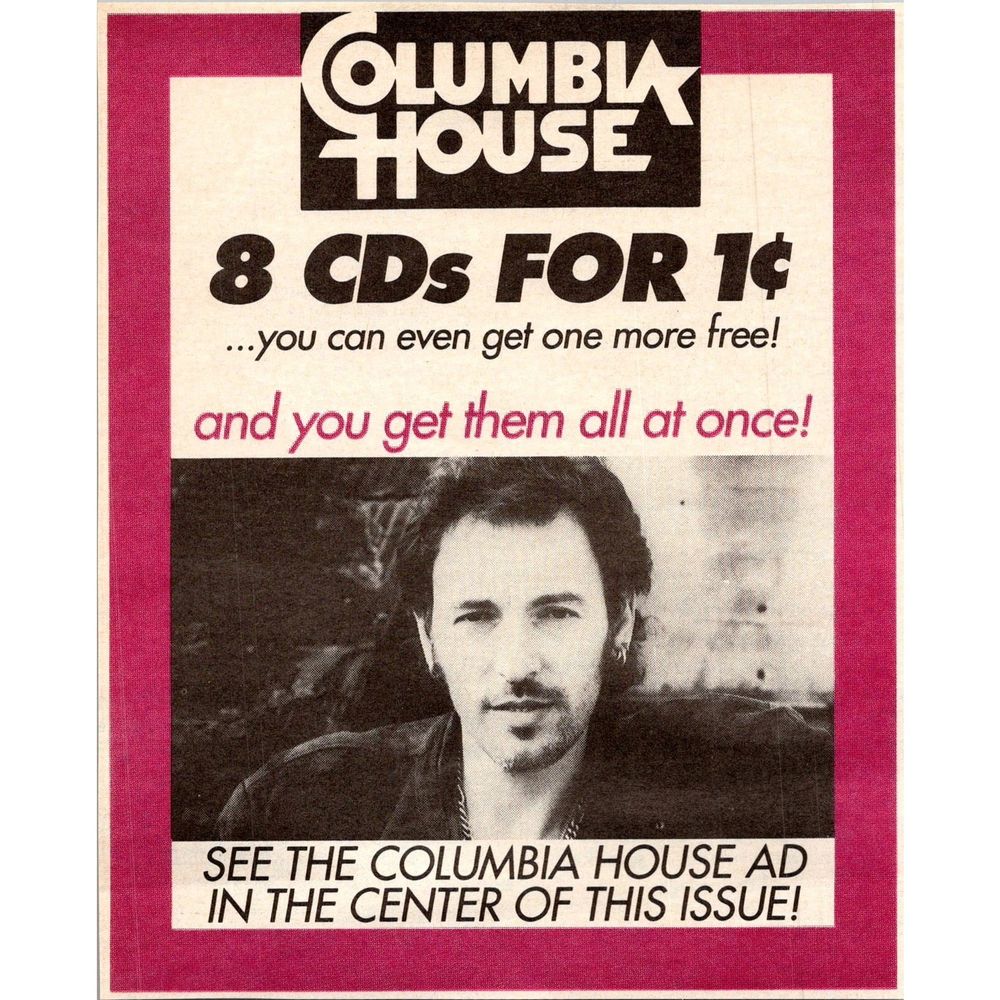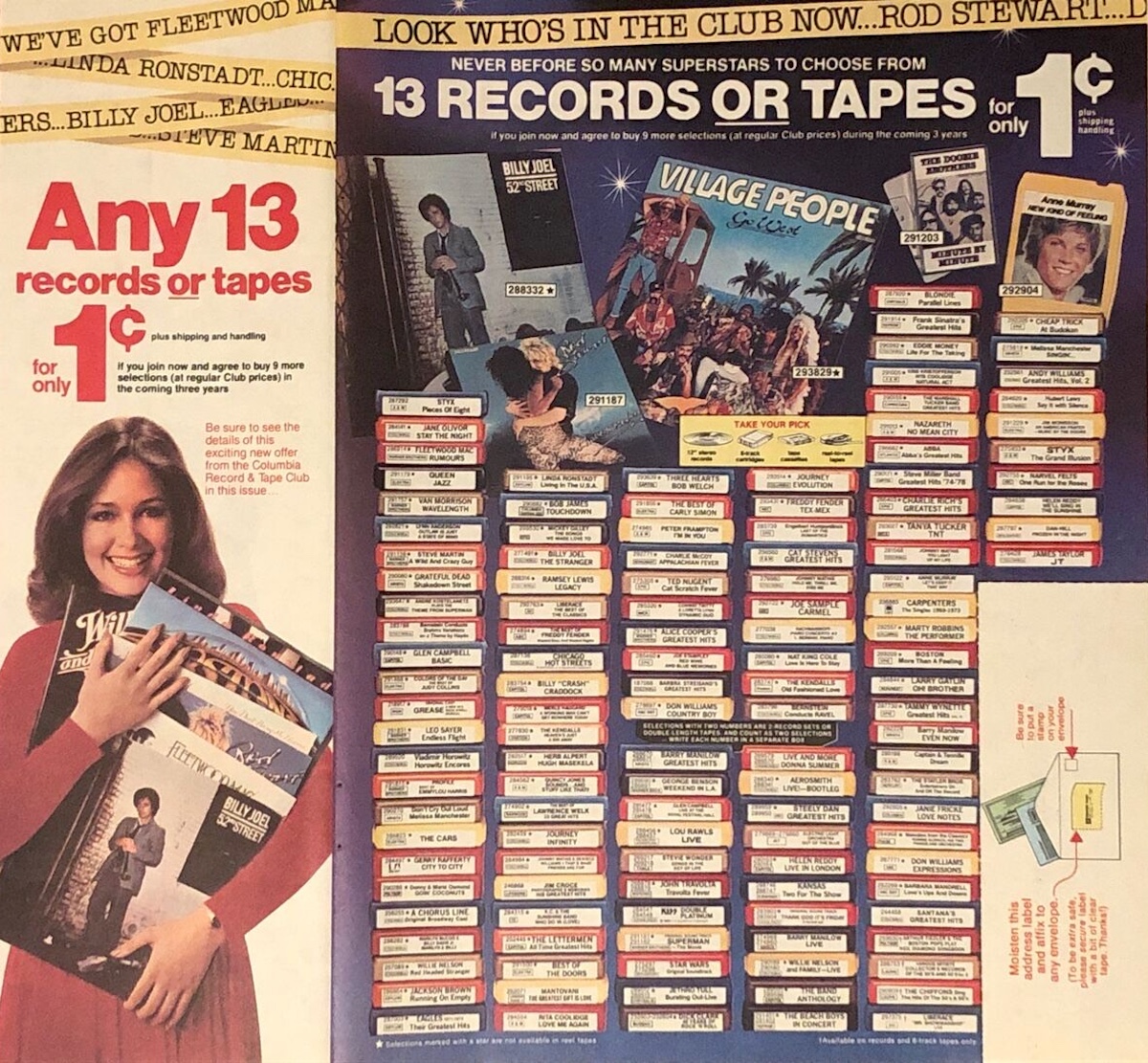
Letter From the Publisher
Published on Nov 29, 2025
Giving Thanks
Published on Nov 27, 2025
Garfield, Odie, and the Dead Vinyl Years
Published on Nov 4, 2025
How Doo Wop Saved Me
Published on Nov 2, 2025
More Liner Notes…
Featured Essay: Eight Records for a Penny: record clubs and me
by Joe Corey

My dad was stationed in West Germany during my early years so record albums weren’t a big part of my life. We were assigned to three U.S. bases over five years in the Cold War hotspot. My parents’ collection of vinyl was stashed away in longterm storage back in the states. I had no idea that most of their collection was jazz, folk, Broadway cast recordings and comedy. The Post Exchanges had tiny record sections that might have been two bins wide. My tiny private collection consisted of the latest Sesame Street releases. I was content with a batch of records that easily fit in my arms. Our possessions were packed up in boxes and sent off for transatlantic shipping a few days before we returned to America in the summer of 1975. We ended up staying at the apartment of a Lieutenant my dad knew. He’d gone off on vacation or something and graciously gave us the key. What I remember the most about the stay was his massive record collection in the living room. He had a lot of Grand Funk Railroad including E Pluribus Funk. The album made an impression since it was silver and shaped like a coin. I didn’t play the record since nobody wanted an 8 year old touching their turntable. The experience made me want more.
When we got back to America, my young mind was blown when we went to a mall and saw an entire store dedicated to selling records. There were bins and racks filled with record albums. Most of the rock groups were foreign to me since I only knew the ones approved to be played on Armed Forces Radio. Even with my lack of musical knowledge, I craved albums that didn’t feature Muppet singers. The hitch in this goal was my lack of money. My folks kept putting my birthday money in a mysterious “college fund” bank account. Without cash, all I could do was stare, drool and plot during visits to the Record Bar.
Turns out there was a solution that was in every magazine my mom subscribed to. It was even in the Parade magazine that arrived in the Sunday newspaper. The Columbia Record Club advertised furiously with two pages that listed all the cool records that you order directly from them. The mail-in coupon declared that I could get 8 albums for the price of a single penny. Just write down my selections, tape a penny to the card and drop it in the mail box. There was also the RCA Record Club. Both clubs had been around since the ‘50s so they weren’t scams like Sea Monkeys who didn’t look like the drawings in my comic books.
This seemed like the perfect way to start a collection. Instead of just doing it by myself, I asked my parents during dinner if I could join the Record Club. There was no way I could sneak this into the house like a pack of Charlie’s Angels trading cards bought at the 7-Eleven. Mom might notice a record shape box being delivered by the mailman while I’m in school. I brought the ad to show the outrageously great deal. And I even showed them the penny I’d use as payment.
He perused the advertisement and declared, “No.” I immediately threw up a “Why?” and braced myself for the usual “because I said so” shutdown retort. Dad shocked me by saying, “Because it’s a rip-off. You get 8 records for a penny, but then you have to buy 8 more records at full price including shipping and handling.” He pointed out the small type below the offer. This was before he earned his law degree. He was a natural at spotting the scam in a contract. The dream of “free records” vanished in the wake of the eight I’d have to buy plus the shipping and handling fee charge per record (whatever that was). I reluctantly agreed with dad that it wasn’t a great deal. There was nothing worse than admitting your parents were right.
Of course at no point did Dad mention taking me to a record store so I can pick up an album at a lesser price. At least convinced me to not waste my penny on signing up for the record club behind his back. I still looked at the ads and played the “what 8 would I get” game and wished the deal was better.
During junior high days, I dropped by my pal Rob’s house. There on the coffee table was a cardboard box for a recently delivered album from the Columbia House Record Club. I was a bit in awe of it. He let me touch the vinyl. I can’t remember the title of the record, but I was struck by how it didn’t look like the version found at the record store. The dust jacket wasn’t the same as I’d seen at the record store. Plus there was a note on the back of the cover declaring the album was a Record Club edition. That sounded ominous. It almost felt like a counterfeit copy. While absorbing the disappointment, Rob handed me the most recent monthly catalog from the club. I studied the pages of album selections like a weathered and greening copy of Oui magazine found by the creek. There were titles I hadn’t seen in the magazine ads. Quite a few I wanted. I was tempted to join when Rob told me how each month he gets the magazine with the album of the month on the cover. If he didn’t immediately send the card back letting the company know he didn’t want that record, it would be shipped to him in two weeks. I already had the ability to procrastinate like a fully grown adult so remembering to mail back something promptly put an end to the dream of joining once more. My birthday thank you cards remained unsent to relatives after three months. Don’t ask about Christmas.

When I began buying used records in college, I noticed the better shops had a “No Record Club Albums” policy. You were better off trying to convince the owner into buying your K-Tel collection with 40 hits squeezed onto a single disc. Why did it matter? The story is that the record clubs used inferior masters and lower quality vinyl. The cassettes they shipped were supposedly even more cheaply made and mastered than the discount ones sold in plastic bags. John Swain at the Record Hole told me that the only reason there were record club albums scattered in his bins was because someone had died and their parents just wanted to dump their entire collection without having him go through it album by album. He wasn’t going to throw the Record Club version in the dumpster, but he charged a buck less than the real used copy. “Don’t bring that crap here!” he warned me. I only brought him review copies sent by the labels to my college paper. I was not tempted to join the record clubs at this time since most of the music I enjoyed was rather obscure and wasn’t being sold with the Best of the Doobie Brothers and Boston’s first album. No Record Club was carrying Psychic TV, Husker Du, King Crimson, The Flying Lizards or The Jazz Butcher Conspiracy.
This is not an article about how I never joined a record club. Because I gave in when the ‘90s struck. Why? Two things had changed. The record clubs got out of vinyl and cassettes and focused on compact discs. Their shiny discs seemed to have the same level of quality as the versions released in stores. Second was the BMG Record Club (BMG took over the RCA records and the club in 1987) came out with the astonishing offer of 8 for the price of 1. They later jacked it up to 12 for 1. If you looked in the right magazines, you only had to pay ½ price to fulfill the deal. It was a real deal with no catch. The secret was get your free CDs, buy the one (or half), get your remaining freebies and quit. There were still quite a few kids eager to scam the clubs. One friend who will remain anonymous ordered their free discs using the next door apartment’s address. The neighbor brought the box they thought the postal carrier stuck in the wrong mailbox. My friend gladly swore they’d fix that address mistake. Instead they moved and stuck the neighbor with the record club’s nasty letters and eventual threats from creditors. I always paid for my compact discs from the Club.
The mid-90s proved to be a boom time as the clubs had over 10 million “members.” I put that in quotes because plenty of people were signing up for multiple accounts to take advantage of the deal including myself. As I grew addicted to growing my CD collection, I couldn’t wait to close an account to start a new one. I turned my house into an apartment complex with tenants that had a variation of my name. I would juggle five accounts at once. I saved up catalogs and marked them for the albums I craved. My postal carrier didn’t care about locating apartment 3-G. It all was dumped in my mailbox in front of the house. Things got wilder when BMG came up with a phone number that let you call up and discover every album title they had for a group. I went nuts with massive collections of Elvis Presley, The Beach Boys, David Bowie, Patti Smith Group, Talking Heads, Frank Zappa and Led Zeppelin. Columbia House stuck to lame deal that my dad had exposed. I never joined them. But in the mid-90s, they somehow introduced CDHQ which ran the same deal of 10 for 1 deal as BMG except you could access records on the Columbia label. This meant a massive amount of Bob Dylan, Miles Davis and Glenn Gould arrived. I was able to order boxsets at this time. The clubs put up sites on the internet so you knew exactly what they had in stock without the phone wizard delays. I could start a membership without mailing in a card. Who needed a record store? Not me.
I shouldn’t gloat too much because the Record Clubs weren’t great for the artists. Their royalty rate on a record club sale was less than if it sold at the Record Bar. Making it worse was the record chosen as free supposedly had no royalty attached since they were considered promo copies - like if the label had sent the album to a radio station for a giveaway. The only positive thing was the record club sales were counted as part of your regular sales for Gold and Platinum Records achievements. The story I heard was that three million copies of Hootie and the Blowfish’s Cracked Rear View were sold through the record club. But over a million of them were given away free. This might have been why Hootie and the Blowfish refused to let the follow up Fairweather Johnson near a record club.
The 21st Century saw the fast demise of the record clubs. The arrival of Napster meant kids no longer needed to join and scam them. The computer savvy youth could just download the music for free without a chance of screwing up their credit rating. CDHQ vanished first so there was no more access to titles that were usually offered by Columbia House. BMG stopped major vault titles and boxsets from being part of the freebie selections. It became no fun. Columbia House was sold to the Blackstone Group in 2002. Barely three years later BMG bought Columbia House so the rivals became one. Like so many companies, they stopped advertising in magazines and relied on the internet. This meant you couldn’t set up multiple accounts since they wanted your credit card and not a personal check. I didn’t want to give them my credit card since they might charge upon shipping for the album of the month if I forgot to send in the card on time. That could be six copies of the same album depending on the month. Then another investment group bought the merged company in 2008 to rename it Direct Brands. By 2010 that company stopped offering compact discs. I was a jolt to discover there would be no more record clubs although I’d been clean of my addiction to them for several years. It didn’t hit as hard as when John Swain died and the Record Hole shutdown. I still had CDs on hold there.
In the end, what I miss the most about the record clubs are the advertisements in magazines. It was an easy way to know what records had recently been released. Now I just wander into School Kids and feel surprised that an album is on the shelf.
Joe Corey III is the mastermind behind the Casino Audiophiles and an ex-member of The Eskimo Sisters. He created the series Danger! Health Films that stars Randy Jones, the Original Cowboy from the Village People and Doug McMillan of The Connells that is on NightFlight Streaming. He sometimes produces the Oakmoon Orchard Record Crates that sell at the School Kids Records in Raleigh, North Carolina. He currently writes reviews for InsidePulse and The ’80s Teen Flick Festival Guidebooks.

